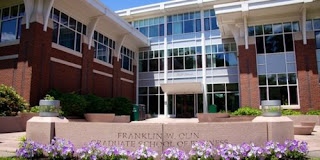Chenting Zou, an MBA Class of 17 student has written the following blog about a typical day in the INSEAD MBA program.
As the end of P1 is nigh, I thought it’s about time I start recording my INSEAD experience. Overall, this first term has been chaotic, thrilling, perplexing, and a lot of fun. I suppose it was €14,700 well spent.
Inspired by a recent company presentation called, “Day in the life of [prestigious consulting firm] employee”, I had the urge to capture a snapshot of a recent (and typical) day in P1. Before I applied to INSEAD, I didn’t know much about what I would do on a day-to-day basis, so I hope this is useful for people who are thinking about coming here and those who have been admitted but aren’t yet quite sure what a daily MBA life entails.
[Please note that this is only my daily routine, which is certainly not representative of all INSEAD students.]
7:30am – Wake up and leave for campus within 20 mins. I chose to rent a studio that’s halfway between the train station and INSEAD, so it’s a zombie-like 30 minute walk every morning.
8:20am – Arrive on campus, rush to get a cup of free coffee at Freddy’s bar. Down one cup, and fill it up again for the lecture.
8:30am – First lecture of the day was Prices and Markets. After discussing microeconomic theory about pricing pharmaceutical drugs, the whole class plays a game theory exercise.
10:00am – Play a quick game of Foosball in Freddy’s. Get another coffee in the 15 minute break before the next lecture.
10:15am – Financial Markets Valuation class. My favourite 🙂
12:00pm – Skip the optional Uncertainty, Data, and Judgment tutorial for a presentation on Amazon job interviews.
1pm – Speedy lunch with section-mates. We chat about last night’s Robin Hood Valentine’s auction, and the various students and staff who were “sold” for charity.
2pm – Coffee chat with fellow 17D’s and a 17J about his pre-INSEAD consulting job.
3pm – Waste two hours walking to the bank in Fontainebleau centre and trying to explain for the third time that my bank card has still not arrived. Nothing :/
6pm – Work on a group assignment with my five group mates. We’re getting better at splitting the questions so this one took much less time than the previous assignments.
7.30pm – Enjoy the tapas, sangria and live music at Freddy’s as part of Iberian week.
10pm – Get home and catch up on emails.
Receive email reminder about the P2 Managerial Accounting exemption exam. After spending the next hour reading through textbook chapter summaries, I come to the realisation that spending four hours trying to cram the content for an exam I had a low chance of passing wasn’t worth it. Decide to prepare on imminent summer internship job interview instead.
Receive email about the upcoming bidding process for campus exchange. Mild panic. Book appointment with career coach to figure out my employability in Asia.
12am – Skype a friend from London and we arrange a trip to Lisbon, along with other INSEAD-ers, between P1 and P2.
1am – Collapse in bed.
Chenting Zou, MBA’17D
Chenting was born in China but spent most of her life in the UK, with the exception of a two year stint in Singapore and Hong Kong. She has 4 years' experience in the healthcare sector and her latest job before INSEAD was at a mobile health app that delivers AI triage and online doctor consultations. In her spare time, she enjoys dabbling in salsa, painting and Louis Theroux documentaries.
For more information, please check out The INSEAD MBA Experience blog








